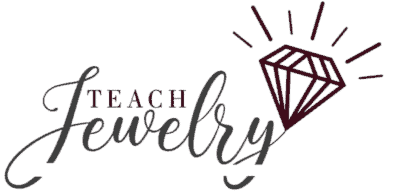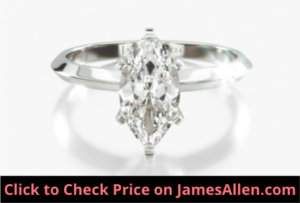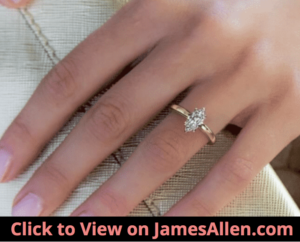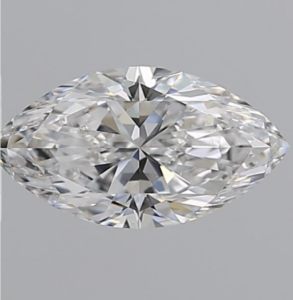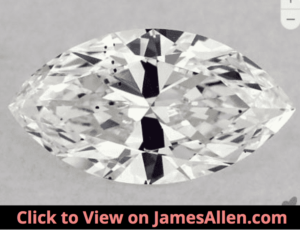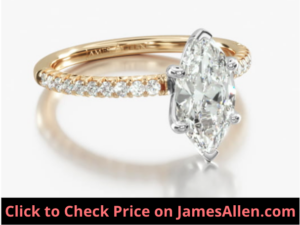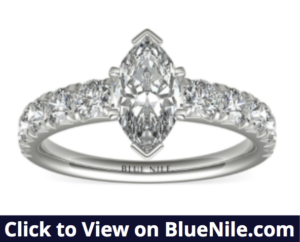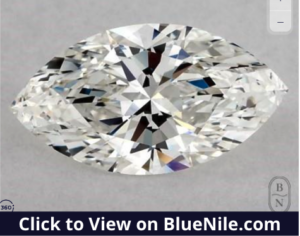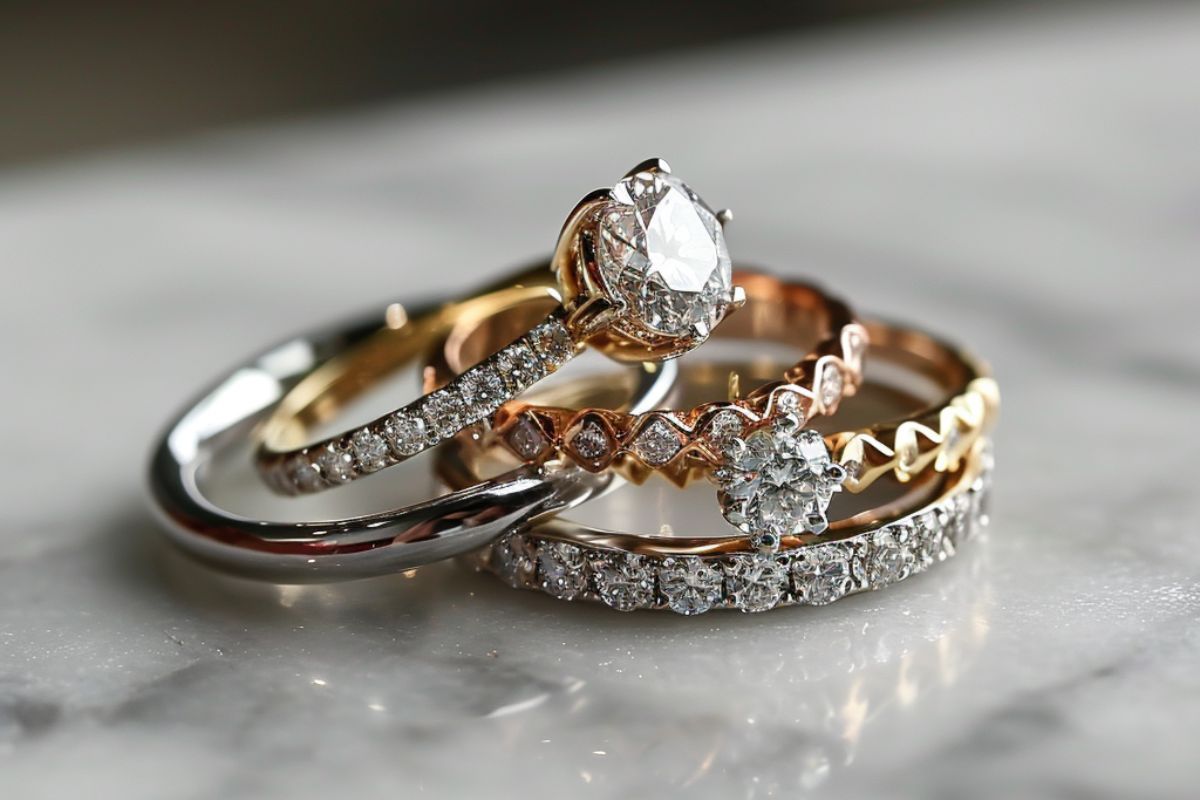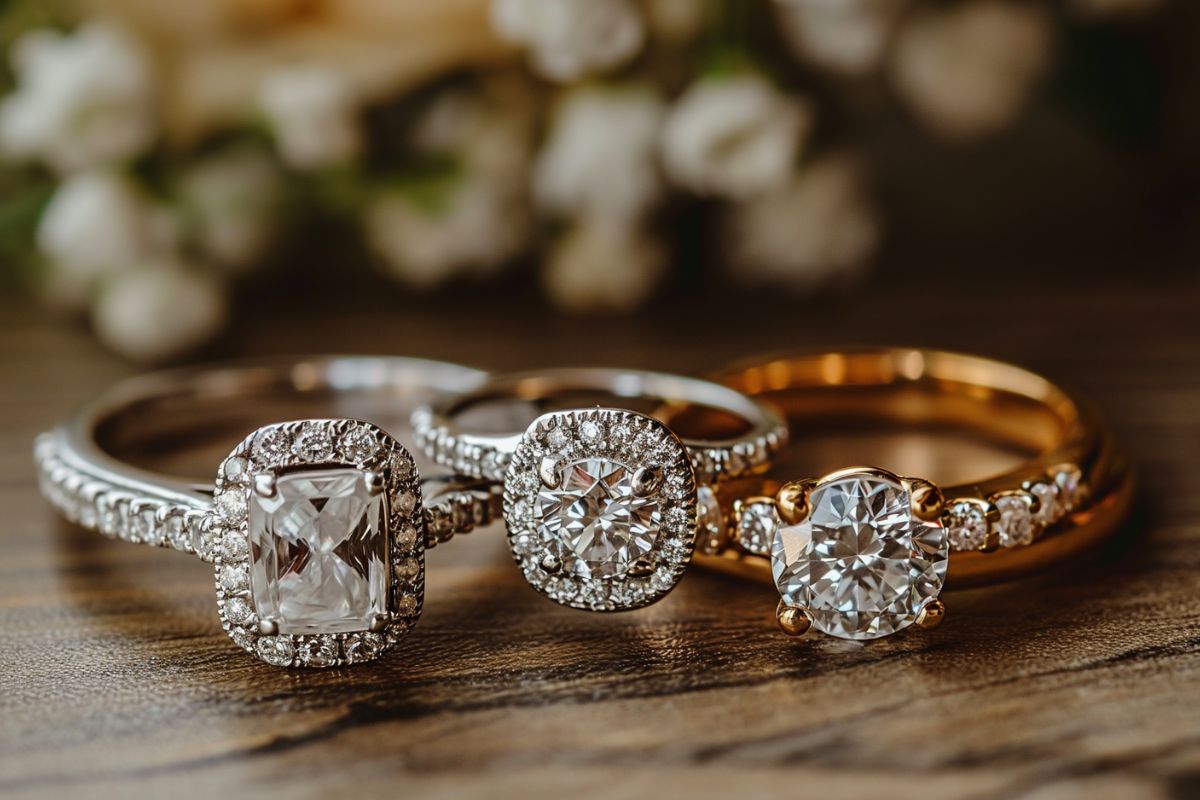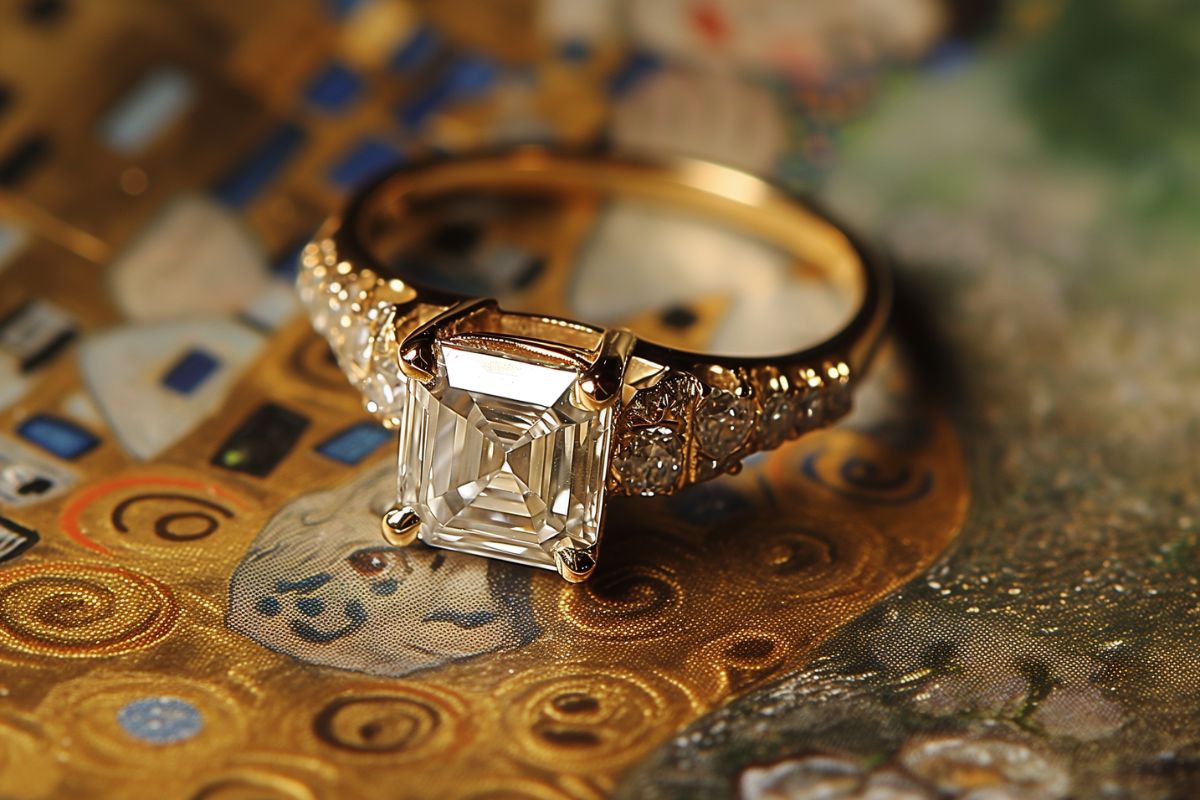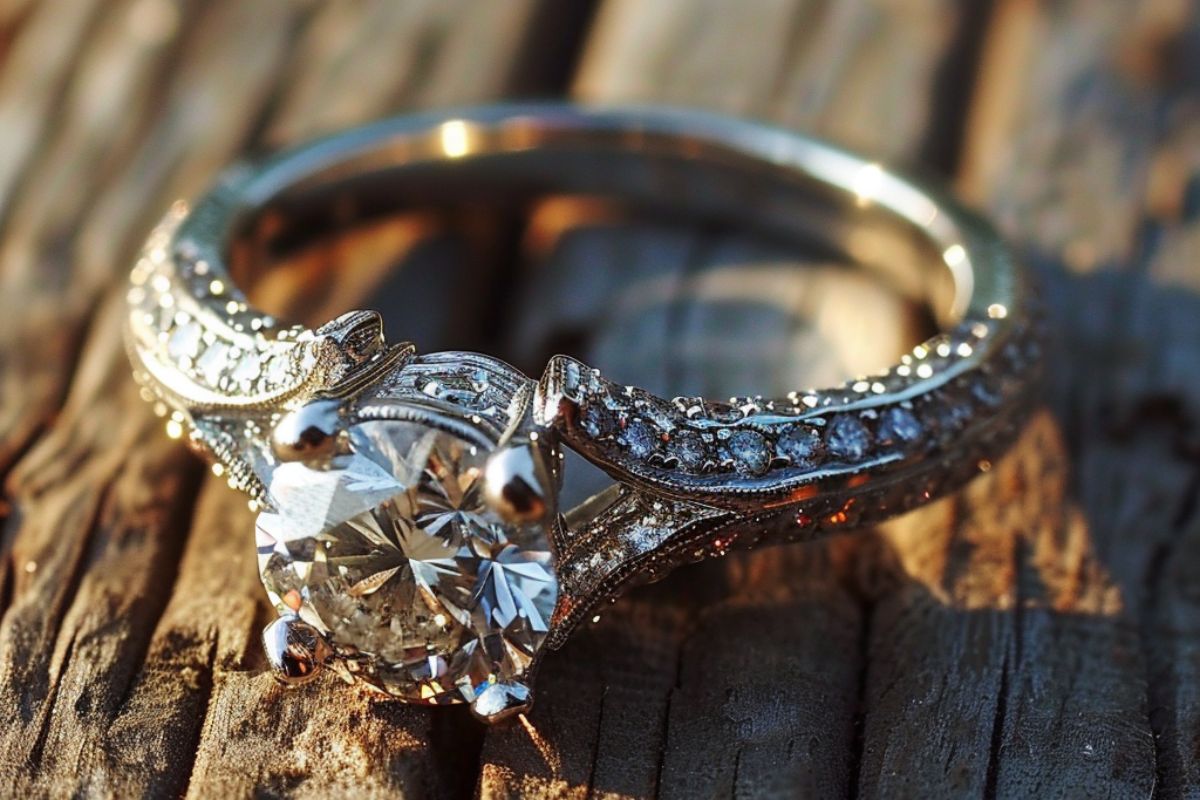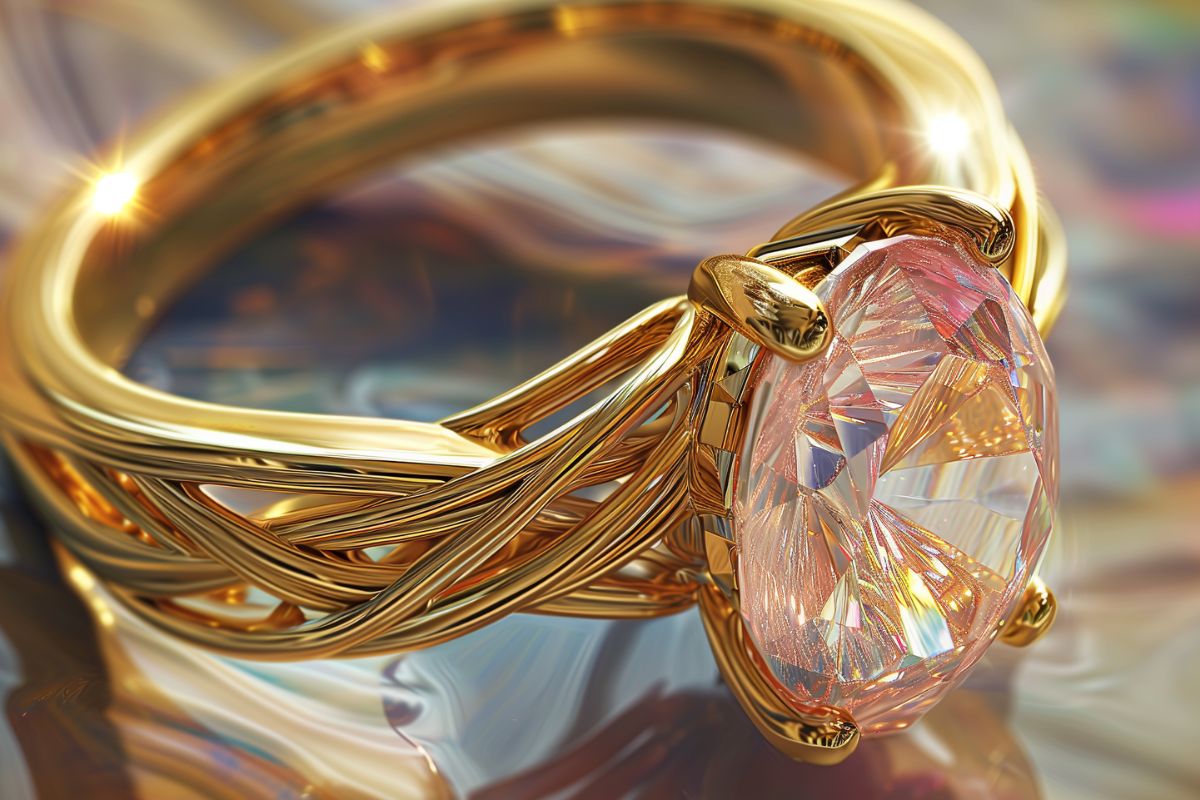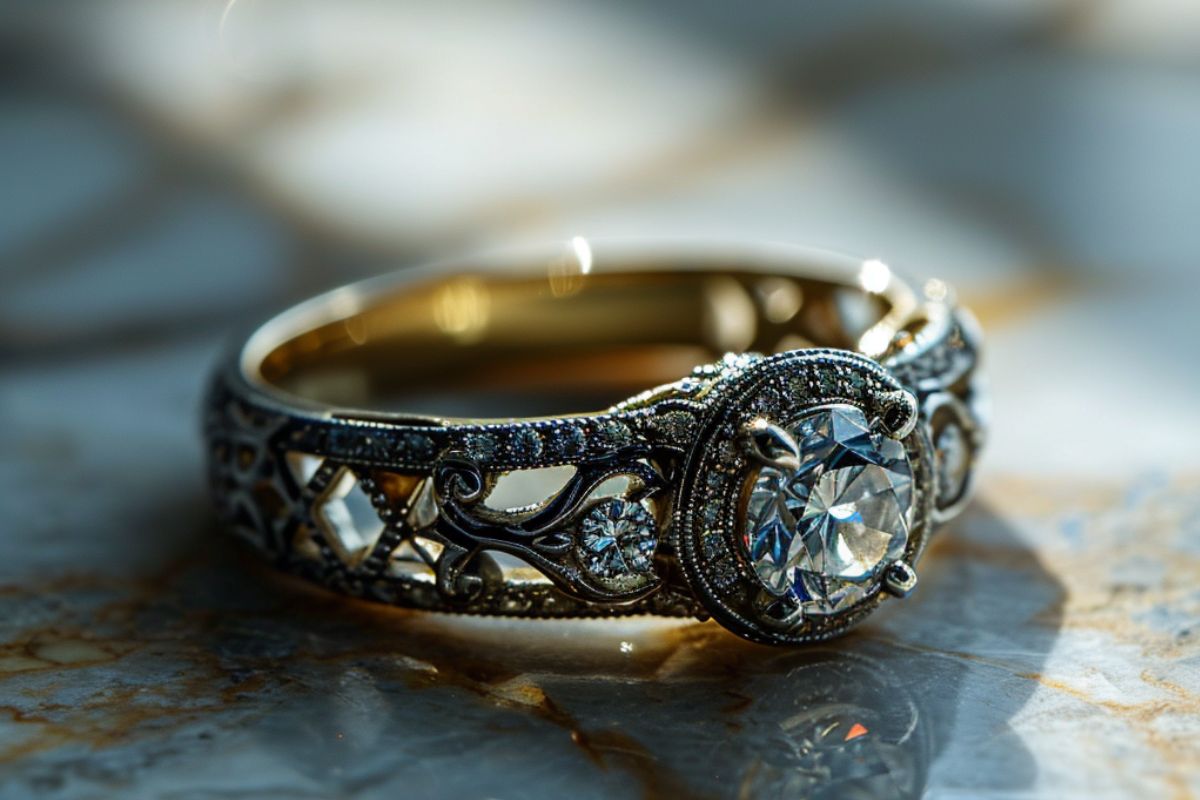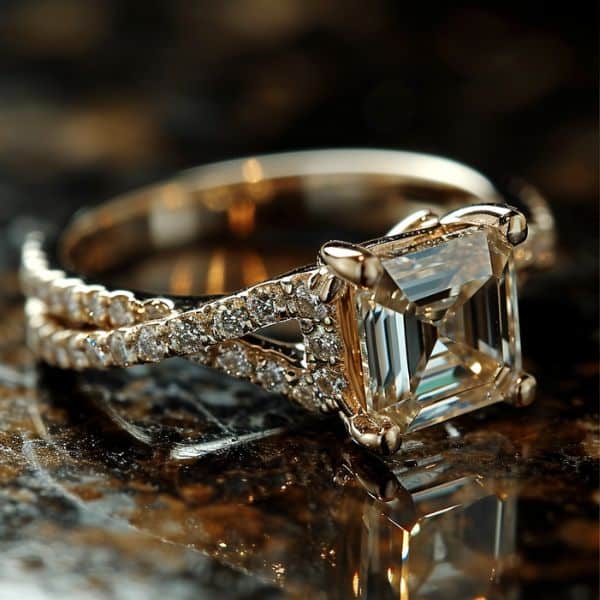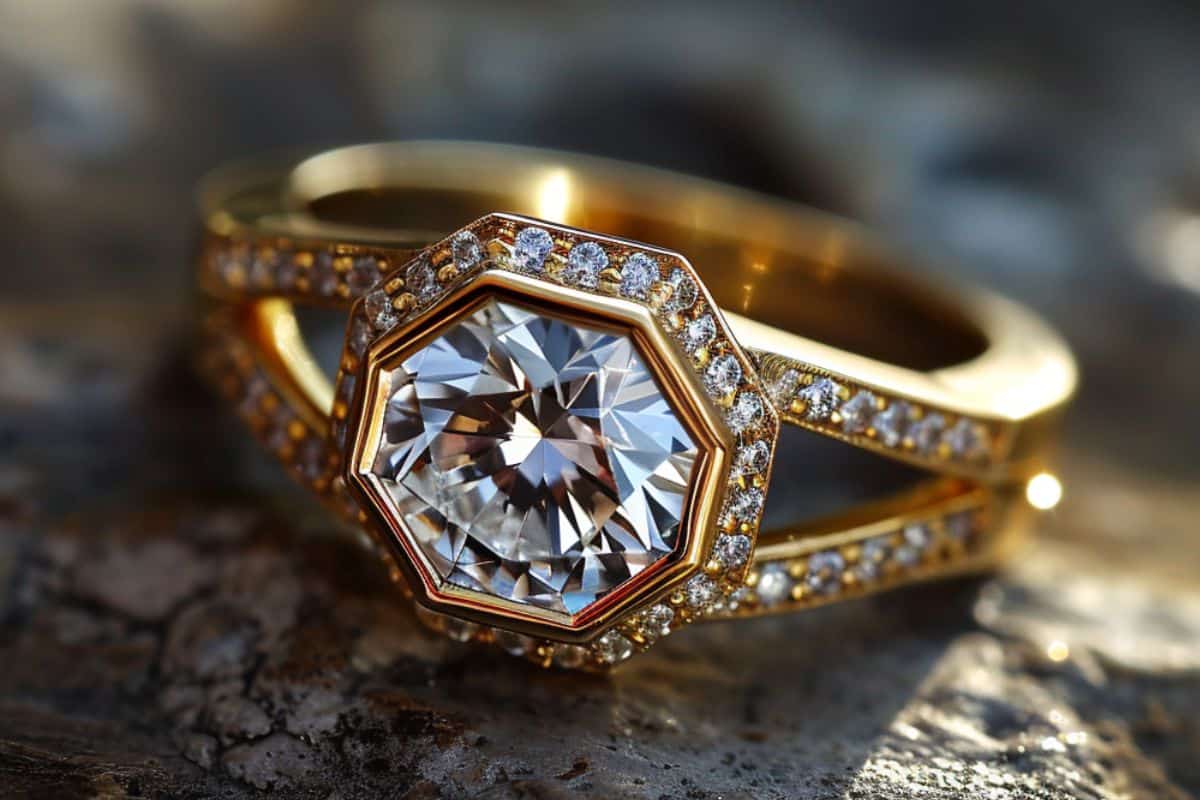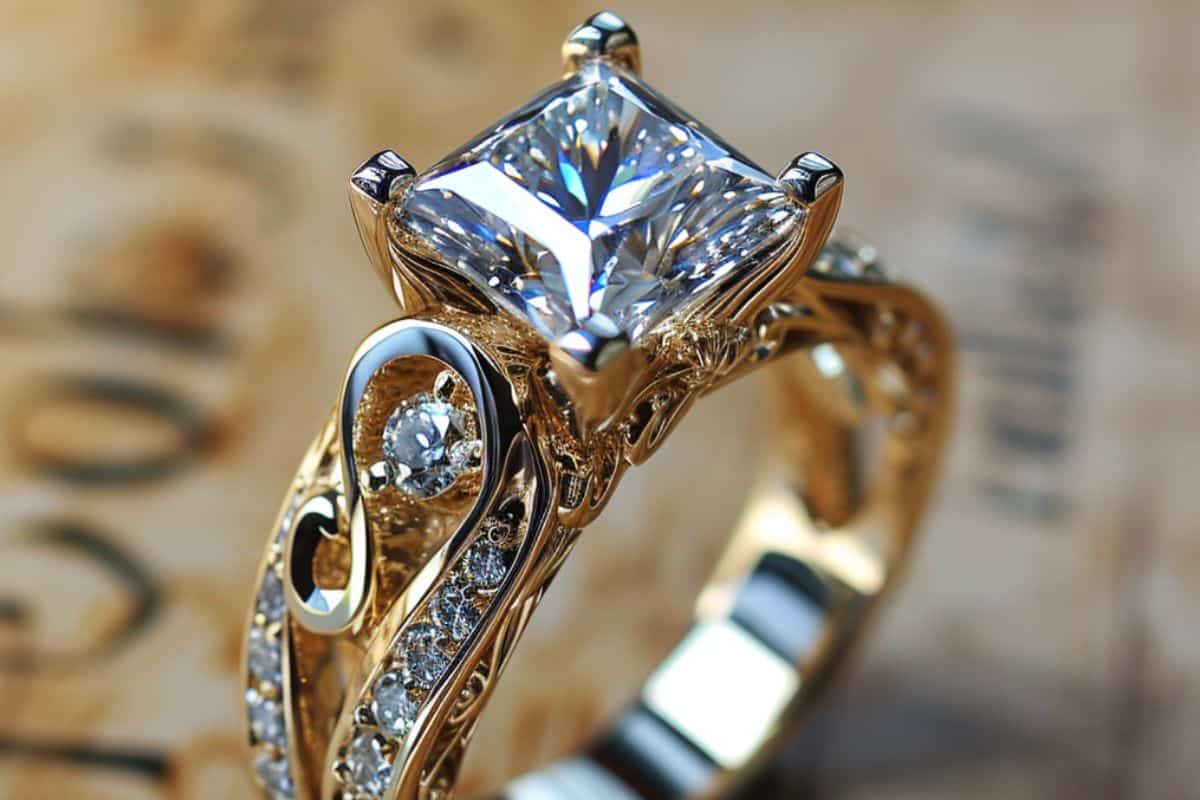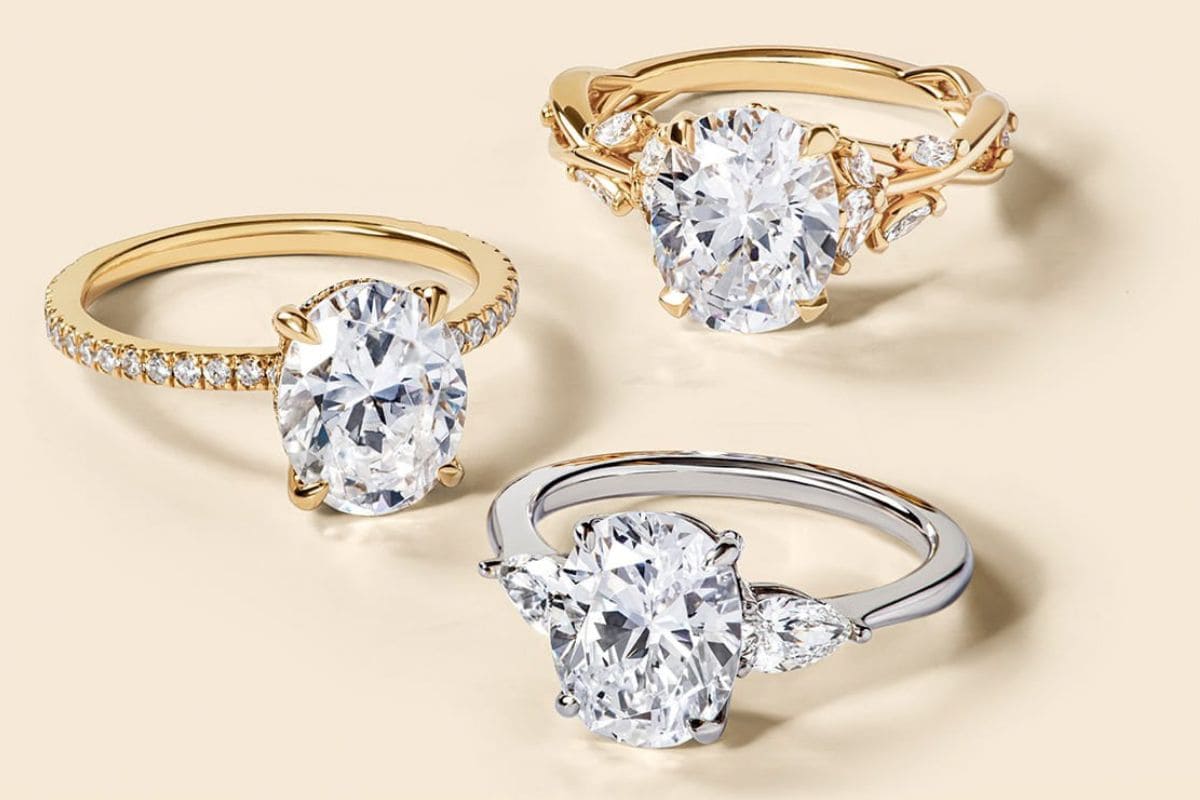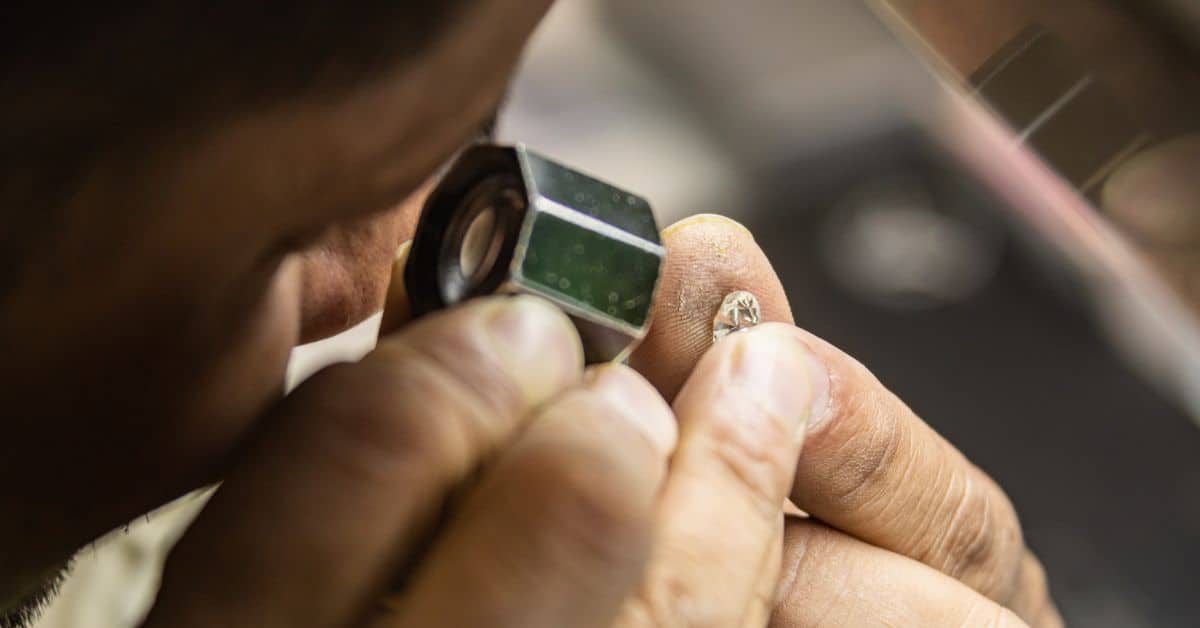
Marquise cut diamonds are a popular fancy shape for engagement rings and other pieces of jewelry.
They feature a wide middle that extends to sharp points on both sides.
It’s a modified brilliant cut, so its facets are shaped similarly to those of a round brilliant. Thirty-three are located on the crown, and 25 are on its pavilion.
The result is a diamond with strong brilliance and fire that offers an alternative to traditional round cuts.
Let’s dive into nine pros and cons of marquise cut diamonds, so if you know if it’s right for you.
Pros of Marquise Cuts
Looks Larger Than Other Cuts
A diamond’s size is often a primary consideration.
It’s well known that large diamonds are more valuable than small ones because of their rarity and the way they draw attention to any piece of jewelry.
The size of a diamond is measured in carats. Carats is a unit of weight equal to 0.2 grams. If two diamonds both weigh one carat, they’re the same size, even if one appears bigger.
But different cuts appear larger than others, even if they’re the same weight.
Marquise diamonds are known to look larger than other cuts because of its elongated shape. Its stretched surface area makes the diamond appear bigger than shapes that are more condensed.
The image below compares the shape of marquise, princess, and cushion cuts.

Notice the length of the marquise cut compared to the squarish shape of the other two.
If you placed a one-carat marquise cut next to one-carat princess, baguette, round, and radiant cuts, the naked eye would view the others as smaller compared to the marquise cut.
So a marquise diamond allows you to save money with a smaller diamond that will look comparable in size to other cuts, even if they have a higher carat weight.
Makes Fingers Appear Slim
The cut of a diamond doesn’t only affect the appearance of the ring itself. In the case of a marquise cut, it accentuates your fingers to make them appear slimmer and longer.
It’s a result of its elongated shape that stretches down your finger in a way princess, emerald, and other cuts don’t match.
In the image below, notice how the marquise cut is placed vertically on the finger.
This creates the slimming effect.
For some, this isn’t a desired trait. If you’re set on a marquise cut but don’t prefer its slimming effect, I recommend choosing a small one that doesn’t stretch as far.
Lower Price Per Carat Than Round Cuts
Another pro of marquise cuts is they cost less than round cuts. The price of a diamond is determined by many factors such as:
- Color
- Carat
- Symmetry
- Clarity
Price is also impacted by the cut of a diamond, so you’ll see differences in cost between cuts, even if its other qualities are the same.
For example, I compiled prices for dozens of marquise and round cuts from Blue Nile with the following qualities:
- Color: G
- Carat: 1.00
- Clarity: SI2
The average price for a marquise cut with those qualities is $3,993. The lowest price is $3,454, and the highest is $4,437.
For a round cut, the average is $4,441, with a range from $3,838-$4,963. The reason there’s a range of prices is because even if the four Cs are identical, the specifics of grades like clarity, color, and cut may differ.
I also analyzed prices at James Allen, another leading online diamond vendor, and found similar results.
For a marquise cut with those traits, the average price is $4,840.
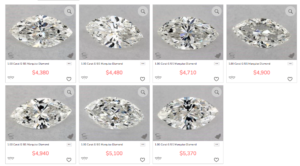
For a round cut, the prices average $5,217.
This shows marquise cuts often cost seven to 10 percent less than round cuts.
Brilliance Hides Inclusions
Marquise diamonds are a modified brilliant cut. Its facets are cut similar to round brilliants, which means they’re triangular or kite-shaped. But its overall shape is distinct.
The facets are designed to maximize the way light is collected and returned to the viewer.
Check out the marquise cut diamond ring below.
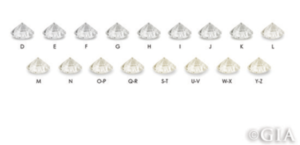
Even in that high-resolution image, you can see it’s an eye-clean stone.
Strong light performance can hide inclusions. These imperfections in a diamond can show up as black spots, white feathers, or transparent twinning wisps.
If they’re large or dark enough, inclusions are visible to the naked eye and diminish the diamond’s appearance.
Brilliant cuts such marquise diamonds can disguise inclusions that would otherwise be visible in diamonds with less brilliance.
The white light reflecting off the diamond and back to the viewer covers flaws and makes them appear eye-clean.
This allows you to choose a lower clarity grade than you could with a step-cut diamond that cannot hide inclusions.
I recommend starting your search at SI1, but you might have to move up to VS2 to ensure eye-cleanliness.
For example, here’s a one-carat marquise cut with SI1 clarity.
The GIA report shows five types of clarity characteristics, but they’re difficult to identify through the image.
It’s a way to earn strong value by avoiding the premiums for higher clarity grades because they appear identical when viewed in a normal setting.
Cons of Marquise Cuts
Bow-Tie Effect
The bow-tie effect is present in most marquise cuts. It appears as black lines across the middle of the diamond in the shape of a bow-tie.
Often, there are multiple rectangles spanning its table.
The bow-tie is obvious in the marquise cut below.
Notice how it spans across the whole table, with the dark spots nearly connected.
While most marquise cuts have the bow-tie, its degree of visibility changes depending on the quality of the diamond.
In some instances, it’s invisible to the naked eye. In others, it can be seen clearly no matter which angle the light hits it.
You can’t tell from a diamond’s grading report whether it has the bow-tie effect. A diamond can have strong grades across symmetry, polish, and more but still have the dark lines.
That’s why it’s important to view the diamond in person or through a high-quality image online before purchasing.
More Expensive Than Other Fancy Shapes
Marquise cuts are often more expensive than other fancy shapes such as:
- Emerald
- Baguette
- Cushion
- Asscher
- Radiant
For example, we compiled the average price for a radiant cut from Blue Nile with the same qualities as the marquise cut discussed above.
While the marquise cut had an average sales price of $3,993, the radiant cuts averaged $3,211.
The radiant cut costs 20 percent less than a comparable marquise cut.
As another comparison, emerald cuts with those same qualities from Blue Nile average $2,858.
Whether you’re comparing marquise cuts to princess, oval, or cushion cuts, these examples show how you can often save money by choosing another fancy shape.
Within the category, marquise cuts often command the highest price.
Pointed Ends are Less Durable
The pointed ends on a marquise cut diminish its durability.
In this marquise cut engagement ring, zoom in on the two ends covered by prongs.
They come to a fine point that contrasts its rounded edges.
Sharp ends on a diamond leave it vulnerable to chipping if dropped or struck against a hard surface.
The best way to guard the weak areas on a marquise diamond is with a strong setting.
For example, you can place each end within a V-prong and add four other prongs to hold its edges, like on this ring.
V-prongs are a unique setting for diamonds with point ends because it doesn’t cover as many of the facets, so they’re popular for marquise cuts.
Bezel settings wrap the entire diamond in a ring of metal and offer the most protection.
You can also prevent the pointed ends of marquise diamonds from chipping by adding a halo.
Halo settings surround the diamond with a ring of smaller diamonds.
If one of the accents falls out or chips, it’s a much easier problem to fix than damage to the marquise cut in the middle.
Ends Can Show Yellow
The color of a diamond is graded on the extent to which yellow or brown tints are present. Colorless diamonds earn the highest grades from the GIA, while ones with yellow or brown are considered less valuable.
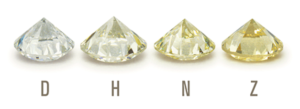
Some diamond cuts show color more strongly than others. Factors include the cut of its facets and the overall depth.
The brilliant cut facets on a marquise diamond hide color better than many step-cut diamonds, but its narrow, shallow ends can show tints of yellow even if the middle is colorless.
If it’s graded an I color by the GIA, its ends may appear closer to a J color grade.
This is another reason you shouldn’t buy a diamond unless you’ve viewed it in person or online with magnification.
As a general rule, you should choose one color grade higher for a marquise cut than if you were buying a round cut.
Start your search with an H color diamond, like this one.
As you move to larger carat weights, you might decide a G color diamond is right for you.
Doesn’t Receive Cut Grade From GIA
Many diamonds come with a GIA report that verifies its qualities across a number of areas.
They’re most known for developing the four Cs of carat, cut, clarity, and color.
A diamond’s cut affects its brilliance more than any other quality. It involves many factors such as its symmetry, polish, durability, brightness and more.
On this GIA report, you can see its symmetry and polish are graded “good.”
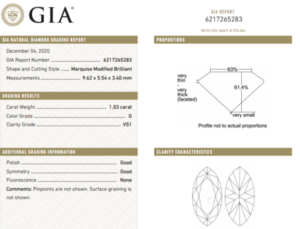
Both diminish its overall cut.
Marquise diamonds don’t receive a cut grade from the GIA because it’s a fancy shape.
The GIA hasn’t developed a standard for grading the cut quality of fancy shape diamonds because there are too many variations.
There isn’t a consistent way to apply standards across so many diamond shapes.
As a buyer exploring a marquise cut graded by the GIA, you’ll have to rely on other measurements to know if it has a quality cut. Take into account its:
- symmetry and polish grade
- proportions
- depth
- girdle thickness
These aspects are available on its GIA report, and you can also view the diamond in person to see how it interacts with light.
Is a Marquise Cut Diamond Right For You?
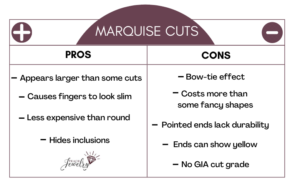
When you understand the pros and cons of marquise cut diamonds, you’ll know whether it’s the right choice for you.
If you’re considering a marquise cut in addition to a round cut or other fancy shapes, here are some guidelines to help you decide.
You should choose a marquise cut if:
- A fancy shape is appealing, but you don’t want to sacrifice too much brilliance
- You’re looking a diamond cut that looks larger than other cuts of the same carat weight
- You want a diamond that’s more affordable than a round cut
- You’re willing to choose a setting that protects its sharp and vulnerable points
If you’ve decided on a marquise cut, compare how it looks on different settings.
By knowing marquise diamond pros and cons and viewing how they fit the overall design of your ring, you’ll find the right diamond for you.

Jacob Clarke
Jacob Clarke is the founder of TeachJewelry.com.
He earned an Applied Jewelry Professional Diploma from the Gemological Institute of America (GIA) and now brings you essential information about diamonds, settings, and more.
Jacob has consulted with leading jewelry brands, and his work has been cited in Clean Origin, Diamond Nexus and industry publications.
He's also a member of the International Gem Society.
He enjoys discussing jewelry with readers, so contact him with any questions at jacob.clarke@teachjewelry.com.
